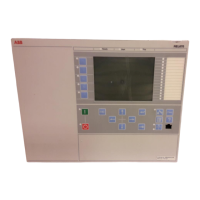The threshold voltages ULowBusEnerg
and ULowLineEnerg, have to be set to a
value greater than the value where the network is considered not to be energized. A
typical value can be 40% of the base voltages.
A disconnected line can have a considerable potential due to, for
instance, induction from a line running in parallel, or by being fed
via the extinguishing capacitors in the circuit breakers. This voltage
can be as high as 30% or more of the base line voltage.
Because the setting ranges of the threshold voltages UHighBusEner
g
/
UHighLineEnerg and ULowBusEnerg/ULowLineEnerg partly overlap each other,
the setting conditions may be such that the setting of the non-energized threshold
value is higher than that of the energized threshold value. The parameters must
therefore be set carefully to avoid overlapping.
UMaxEnerg
This setting is used to block the closing when the voltage on the live side is above
the set value of UMaxEnerg.
tAutoEnerg and tManEnerg
The purpose of the timer delay settings, tAutoEnerg and tManEnerg, is to ensure
that the dead side remains de-energized and that the condition is not due to a
temporary interference. Should the conditions not persist for the specified time, the
delay timer is reset and the procedure is restarted when the conditions are fulfilled
again. Circuit breaker closing is thus not permitted until the energizing condition
has remained constant throughout the set delay setting time.
12.2 Autoreclosing for railway system SMBRREC
IP14559-1 v6
12.2.1 Identification
M14890-1 v7
Function Description IEC 61850
identification
IEC 60617
identification
ANSI/IEEE C37.2
device number
Autoreclosing for railway system SMBRREC
IEC15000204 V1 EN-US
79
12.2.2 Application
M12391-3 v8
Automatic reclosing is a well-established method for the restoration of service in a
power system after a transient line fault. The majority of line faults are flashovers,
1MRK 506 375-UEN A Section 12
Control
Railway application RER670 2.2 IEC 223
Application manual

